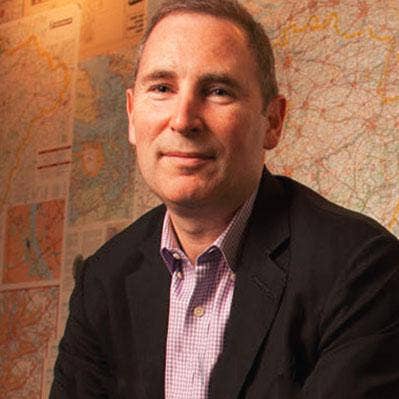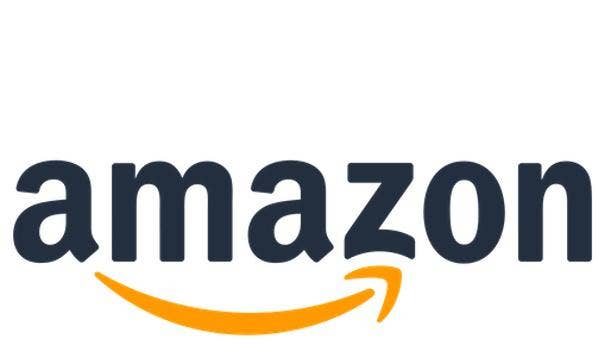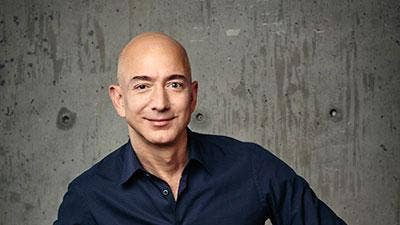5 Things To Know About Andy Jassy’s Transition To Amazon CEO
‘Like the rest of Amazon, AWS is in a very good spot,’ Jassy wrote in a memo to employees. Here’s everything you need to know about Amazon’s succession planning and its S-Team bench, what Bezos had to say about Jassy, and how partners and analysts reacted to the announcement.

Amazon Web Services CEO Andy Jassy told AWS employees there’s “still plenty of time” to determine who will lead the cloud computing division when he takes over as CEO of parent company Amazon.com this summer.
A 24-year Amazon veteran, Jassy launched AWS in 2006 and served as its senior vice president before becoming AWS CEO in April 2016. Yesterday, he was was named as the successor to Amazon founder and CEO Jeff Bezos, who will be stepping down and taking a new role as executive chair of the company’s board.
Amazon made the announcement as part of its fourth-quarter earnings release for 2020 yesterday. The transition is due to take place in the third quarter, which starts July 1. Jassy’s replacement has yet to be named.
In a memo to employees on Tuesday following the announcement, the 53-year-old Jassy said he was excited about what the future holds for AWS, which he has built into a cloud computing powerhouse and industry leader with a $51 billion annualized revenue run rate.
“Like the rest of Amazon, AWS is in a very good spot,” Jassy wrote in the memo, first obtained by The New York Times’ Kara Swisher. “At a $51B revenue run rate, growing 28 percent (year over year), and with the meat of enterprise and public sector adoption starting to happen now, we have a chance to build a very unusual, long-term business. And more importantly, we continue to help millions of new and existing customers not only transform their own companies, but also entire industries. One of the amazing things about AWS and Amazon is that we’re still such a small overall share of the market segments in which we address. It’s still very early days.”
Nothing will change in the short term at AWS, according to Jassy.
“You’ll be stuck with me until Q3, and even after that, I will always be passionate and connected to AWS,” he said. “We have plenty of time to determine in the coming weeks who will lead the AWS business when I assume the new role. We will share those details in the future. We have unusual leadership depth in AWS that, along with all of you, are the heart of the business -- and that doesn’t change. In the meantime, stay giddied up -- we have so many customers needing our help to transform and accomplish what they’re trying to do. We won’t be bored any time soon :-).”
Jassy said he also was excited for Bezos and looks forward to watching him in his “next chapter.”
“Seems a pretty good bet that it’ll be something special,” Jassy said.
Jassy, who started at Amazon in 1997 after graduating from Harvard Business School, served in a shadow role to Bezos in his early years at the company, in a position known as Bezos’ technical assistant or chief of staff.
“It’s hard to overstate how much I’ve learned from Jeff over the past 24 years — from how much I obsess over customers, to the importance of inventing and looking around corners, to the criticality of hiring and developing great people, to the value of high standards and consistently speedy, outstanding delivery,” Jassy said. “I am grateful for the opportunity to lead Amazon, and excited about what the future holds for the company.”
Click through to read about Amazon’s succession planning and its S-Team bench, what Bezos had to say about Jassy, and how partners and analysts reacted to the announcement.

Amazon’s Succession Planning
If Amazon’s moves to appoint Jassy as Amazon CEO and Dave Clark as Amazon’s worldwide consumer CEO are an indication, Amazon could turn to its “S-Team” to select Jassy’s successor as CEO of AWS. The S-Team includes a team of senior executives that meets regularly with Bezos (pictured) to confer on strategic decisions facing the company.
Last August, Amazon announced that Jeffrey Wilke, the company’s worldwide consumer CEO, planned to retire in the current quarter, and Clark, who joined Amazon in 1999 and was its senior vice president of worldwide operations since 2013, would succeed him.
That transition and Jassy’s transition to CEO are both examples of “highly effective succession planning processes at Amazon,” Brian Olsavsky, Amazon’s chief financial officer, told analysts during Tuesday’s earnings call.
“The board of directors obviously takes that very seriously,” Olsavsky said. “It is an annual discussion -- and probably more often -- on succession plans, development of key executives, expanding the number of key executives, etc. And you see the byproduct of that as we expand the S-Team; as we, five years ago, set up the two-CEO structure where Jeff Wilke was CEO of consumer and Andy Jassy was CEO of AWS.”
“We have strong single-thread leaders on devices, video -- including Amazon Studios – advertising,” Olsavsky said. “So I think there’s a lot of bench strength within Amazon and, generally, we do try and push the decisions down in the organization as we scale, especially internationally as we try and do things consistently globally, but recognize local differences in our model. So, having said all that, succession planning is super important.”
Wilke had been viewed as a potential future Amazon CEO before his announcement that he was stepping down to pursue other goals and interests outside the company. Wilke had joined Amazon in 1991 to lead its global operations, and Bezos had said he was lucky to have had Wilke as his “tutor,” saying he was “one of those people without whom Amazon would be completely unrecognizable.”
“(Wilke) had been here over 20 years, had been super pivotal in our development of our consumer business, our culture, the development of layers and layers of leaders,” Olsavsky said. “One of them was Dave Clark, who has, over the last five-plus years, really been charged with developing some very fundamental things for our company: the expansion of the fulfillment center network, the expansion and creation of our transportation capacity, grocery delivery and the grocery plan, a lot of other things.”
Clark’s transition to his new role is wrapping up this month.
“That’s a successful example of succession planning and a successful transition,” Olsavsky said. “Same thing for Jeff Bezos’ role…Andy has been here since 1997. He is not only a visionary leader, he is a strong operator…and he has got a great track record of developing multiple things and businesses within Amazon, not the least of which is AWS, which is arguably the most profitable, important technology company in the world. So that’s just a flavor on the insight on how it works. We’re very happy to see both Jeff and Andy get new perspectives. Andy has a chance to put his imprint on Amazon. He is certainly going to carry through the culture and the vision and the invention factory that Amazon is and will take that to the next level.”
“We will be working on backfilling the AWS role, and we will talk more about that in the future,” Olsavsky said.

Amazon’s S-Team
In addition to Jassy, Amazon’s 26-member S-Team includes three AWS executives, according to a list provided by the company. They are Charlie Bell, a 23-year Amazon veteran and senior vice president whose team is responsible for AWS engineering, operations and product; 16-year Amazon vet Peter DeSantis, AWS’ vice president of global infrastructure and customer support; and 14-year vet Matt Garman, vice president of AWS sales and marketing and former vice president of AWS compute services.
“A question on everyone’s mind is who will be following in Jassy’s footsteps at AWS,” said Jonathan Bauer, a principal and AWS alliance leader at Deloitte Consulting who directs the AWS Premier Consulting Partner’s U.S. go-to-market activity. “They are big shoes to fill indeed. Over the past couple of years, AWS has seen increasing competition from other cloud providers, the company’s rapid growth makes it more challenging to remain nimble, and the war on talent continues to escalate. These issues will likely be on the agenda for whoever takes the helm.”
On the Amazon side, in addition to Bezos, Clark, Olsavsky and Wilke, the S-Team members include Amit Agarwal, senior vice president and country manager at Amazon India; Colleen Aubrey, vice president of performance advertising; Christine Beauchamp, president of Amazon fashion; Alicia Boler Davis, vice president of global customer fulfillment; Jay Carney, senior vice president of global customer affairs; John Felton, vice president of global delivery services; Beth Galetti, senior vice president of human resources; Russ Grandinetti, senior vice president of international consumer; Doug Herrington, senior vice president of North America consumer; Mike Hopkins, senior vice president of Prime Video and Amazon Studios; Paul Kotas, senior vice president of global advertising; Peter Krawiec, vice president of worldwide corporate development; Dave Limp, senior vice president of devices and services; Neil Lindsay, vice president of worldwide prime and marketing; Rohit Prasad, vice president and head scientist for Amazon Alexa artificial intelligence; Tom Taylor, senior vice president of Amazon Alexa; Dave Treadwell, vice president of e-commerce services; and David Zapolsky, senior vice president, general counsel and secretary.

Partners’ Reactions To Jassy’s Forthcoming New Role
Jassy led and built AWS into the “most transformational technology platform and ecosystem in history,” according to Simon Anderson, CEO at Mission, a Los Angeles-based managed services provider and AWS Premier Consulting Partner.
“Andy’s leadership in reinventing infrastructure software and services, and developing powerful new tools for business innovation and growth -- including machine learning and the Internet of Things -- is second to none,” Anderson said. “Importantly, he has been able to combine that technological prowess with an obsession for customer success, which has delivered a winning combination for companies and AWS partners worldwide.”
Once Jassy takes over as Amazon CEO, he could help channel partners more easily engage with multiple Amazon businesses collectively, according to Deloitte Consulting’s Bauer.
Jassy was fast to recognize the importance of partners, and his “partner obsession” has helped drive AWS’s growth, Bauer said.
“He realized that clients’ demand for AWS cloud exceeded what any one company could deliver, especially globally; hence, a strong partner ecosystem was required,” Bauer said. “But he didn’t stop there: AWS invests alongside their partners in large, go-to-market solution ideas. AWS has also built an operation dedicated to providing training pathways focused on AWS service.”
Three years ago, Deloitte’s go-to-market engagement with Amazon was almost 100 percent focused on the AWS business, according to Bauer.
“Not only is our work with AWS evolving and exponentially growing, but Deloitte is evaluating and acting upon a go-to-market relationship with several additional Amazon businesses, such as Twitch, Just Walk Out, Amazon Marketing and Alexa,” Bauer said. “Today, several Amazon businesses have relevance to enterprise customers. The ‘partner obsession’ Jassy pushed at AWS should accelerate the growth of these other Amazon businesses. There is also an opportunity for Jassy to streamline the ability for partners to engage with multiple Amazon businesses collectively and not as individual business units. This would be a huge win for Amazon and its partner network.”
Jassy was the natural heir apparent to Amazon’s CEO role, according to Ambuj Kumar, CEO and co-founder of Fortanix, a Mountain View, Calif.-based multi-cloud security company and AWS partner.
“AWS was born as a result of selling the excess infrastructure capacity Amazon built for its retail business,” Kumar said. “Cloud took off beyond anyone’s imagination. It would take Microsoft eight years to launch its competitive product, Azure. AWS has been providing more gross profit dollars to the company than the retail business. It’s only appropriate that now AWS’ leader is taking over the mothership as if to acknowledge that the cloud now leads the overall direction of the company. In a way, Andy has been groomed for this role for a long time.”
Brad Jackson, CEO of Slalom, called Jassy “the most curious, humble and brilliant CEO of our time.”
“His relentless focus on invention, customer value and opportunity for all is something I think about and am inspired by each day,” said Jackson, whose Seattle-based company is an AWS Premier Consulting Partner focused on strategy, technology, and business transformation.
“Andy and Jeff are a remarkable team, and I believe Andy’s move to become Amazon’s CEO and Jeff’s to executive chairman will create even higher levels of success for both customers and partners,” Jackson said.

What Bezos Has To Say About The Transition
In an email to Amazon employees yesterday, the 57-year-old Bezos said he intends to focus on new products and early initiatives as executive chair.
“Andy is well known inside the company and has been at Amazon almost as long as I have,” Bezos said. “He will be an outstanding leader, and he has my full confidence.”
Bezos noted that millions of customers depend on Amazon’s services, and more than a million employees depend on Amazon for their livelihoods.
“Being the CEO of Amazon is a deep responsibility, and it’s consuming,” he said. “When you have a responsibility like that, it’s hard to put attention on anything else. As exec chair, I will stay engaged in important Amazon initiatives but also have the time and energy I need to focus on the Day 1 Fund, the Bezos Earth Fund, Blue Origin, The Washington Post and my other passions. I’ve never had more energy, and this isn’t about retiring. I’m super passionate about the impact I think these organizations can have.”
“Amazon couldn’t be better positioned for the future,” Bezos said. “We are firing on all cylinders, just as the world needs us to. We have things in the pipeline that will continue to astonish. We serve individuals and enterprises, and we’ve pioneered two complete industries and a whole new class of devices. We are leaders in areas as varied as machine learning and logistics, and if an Amazonian’s idea requires yet another new institutional skill, we’re flexible enough and patient enough to learn it.”

Analysts Weigh In
Amazon’s decision to name Jassy as its new CEO completes the company’s shift from a retailer to a tech company, according to David Bicknell, principal analyst at GlobalData, a London-based data and analytics company.
“AWS is pivotal to Amazon’s business,” Bicknell said. “It accounts for a massive 52 percent of Amazon’s quarterly operating profit, but only 12 percent of total sales. It will continue to be the engine of Amazon’s growth and its most important unit for years to come.”
Technology is at the heart of Amazon’s operations, and its success is driven by its strength in the key themes disrupting the tech, media, and telecom sectors, including cloud, artificial intelligence and the future of work, according to Bicknell.
While Jassy is a proven leader who has overseen AWS’ growth to a $51 billion annual revenue run rate business, JP Morgan has heard concerns about Jassy’s “limited retail experience and what that may mean for a potential AWS (spin-off),” according to analyst Douglas Anmuth.
“But we don’t think a lot is going to change, with Jassy likely to carry on Bezos’ same core values and beliefs given similar operating cultures between consumer and AWS,” Anmuth said in a JPMorgan report today. “And as part of AMZN’s S-Team for years, Jassy has still been close to the consumer business in which he originally started at Amazon. Importantly, we expect Bezos to remain involved in key strategic decisions, and we believe he had already stepped-back from much of the day-to-day decision making since Amazon adopted its consumer and AWS CEO structure in 2016.”
As for an AWS spin-off, JPMorgan does not believe there‘s any urgency given AWS’ strong profit contribution combined with the fact that most regulatory concerns do not stem from Amazon operating both businesses, Anmuth said.
In a June 2019 interview, Jassy said he saw no need to spin off AWS from Amazon -- unless federal antitrust regulators force it.
Jassy’s remarks at Recode’s Code Conference in Scottsdale, Ariz., followed a Washington Post report on a Federal Trade Commission and Department of Justice agreement that put antitrust oversight of Amazon under the auspices of the FTC, and a presidential campaign call from Sen. Elizabeth Warren (D-Mass.) to break up Amazon and other large technology companies.
“I can’t speak to what the government is thinking or will do, but at the end of the day, we operate in the United States, and we will follow the United States laws,” Jassy said at the time. “If we were forced to do it, I guess we would have to do it. We don’t spend a lot of time talking about it.”